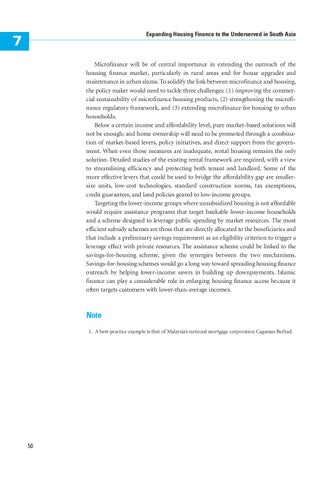Expanding Housing Finance to the Underserved in South Asia
7
Microfinance will be of central importance in extending the outreach of the housing finance market, particularly in rural areas and for house upgrades and maintenance in urban slums. To solidify the link between microfinance and housing, the policy maker would need to tackle three challenges: (1) improving the commercial sustainability of microfinance housing products, (2) strengthening the microfinance regulatory framework, and (3) extending microfinance for housing to urban households. Below a certain income and affordability level, pure market-based solutions will not be enough; and home ownership will need to be promoted through a combination of market-based levers, policy initiatives, and direct support from the government. When even those measures are inadequate, rental housing remains the only solution. Detailed studies of the existing rental framework are required, with a view to streamlining efficiency and protecting both tenant and landlord. Some of the more effective levers that could be used to bridge the affordability gap are smallersize units, low-cost technologies, standard construction norms, tax exemptions, credit guarantees, and land policies geared to low-income groups. Targeting the lower-income groups where unsubsidized housing is not affordable would require assistance programs that target bankable lower-income households and a scheme designed to leverage public spending by market resources. The most efficient subsidy schemes are those that are directly allocated to the beneficiaries and that include a preliminary savings requirement as an eligibility criterion to trigger a leverage effect with private resources. The assistance scheme could be linked to the savings-for-housing scheme, given the synergies between the two mechanisms. Savings-for-housing schemes would go a long way toward spreading housing finance outreach by helping lower-income savers in building up downpayments. Islamic finance can play a considerable role in enlarging housing finance access because it often targets customers with lower-than-average incomes.
Note 1. A best-practice example is that of Malaysia’s national mortgage corporation Cagamas Berhad.
50
